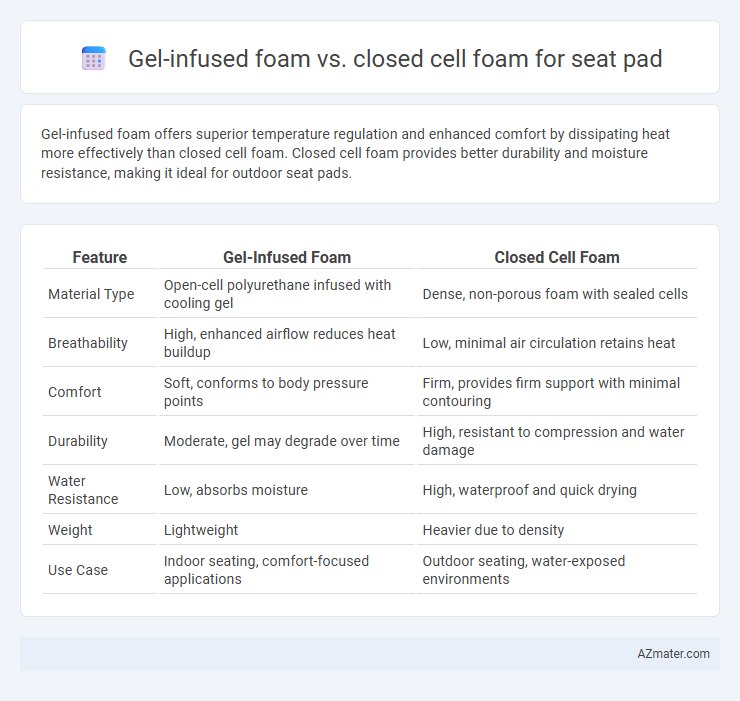Gel-infused foam offers superior temperature regulation and enhanced comfort by dissipating heat more effectively than closed cell foam. Closed cell foam provides better durability and moisture resistance, making it ideal for outdoor seat pads.
Table of Comparison
| Feature | Gel-Infused Foam | Closed Cell Foam |
|---|---|---|
| Material Type | Open-cell polyurethane infused with cooling gel | Dense, non-porous foam with sealed cells |
| Breathability | High, enhanced airflow reduces heat buildup | Low, minimal air circulation retains heat |
| Comfort | Soft, conforms to body pressure points | Firm, provides firm support with minimal contouring |
| Durability | Moderate, gel may degrade over time | High, resistant to compression and water damage |
| Water Resistance | Low, absorbs moisture | High, waterproof and quick drying |
| Weight | Lightweight | Heavier due to density |
| Use Case | Indoor seating, comfort-focused applications | Outdoor seating, water-exposed environments |
Introduction to Seat Pad Materials
Gel-infused foam and closed cell foam represent two advanced materials commonly used in seat pads to enhance comfort and durability. Gel-infused foam integrates cooling gel beads that help dissipate heat, making it ideal for prolonged seating and reducing sweat buildup. Closed cell foam, characterized by its dense, water-resistant structure, offers superior support and resistance to compression, making it suitable for outdoor or heavy-use seating applications.
What is Gel-Infused Foam?
Gel-infused foam is a type of memory foam infused with gel beads or liquid gel to enhance breathability and temperature regulation, making it ideal for seat pads requiring cooling comfort. This material contours to the body while dissipating heat more effectively compared to traditional foams, helping reduce pressure points during extended seating. Closed cell foam, by contrast, is denser and less breathable, offering superior water resistance and durability but often lacking the cooling and pressure-relieving properties of gel-infused foam.
Understanding Closed Cell Foam
Closed cell foam consists of tightly packed cells filled with gas, providing high density and exceptional durability ideal for seat pads requiring long-term support and moisture resistance. Its rigid structure offers superior compression resistance and prevents water absorption, making it suitable for outdoor or heavy-use seating environments. Compared to gel-infused foam, closed cell foam typically delivers firmer cushioning and enhanced longevity, enhancing user comfort and seat integrity over time.
Comfort Comparison: Gel-Infused Foam vs Closed Cell Foam
Gel-infused foam offers superior temperature regulation and pressure relief by dispersing heat and contouring to body shape, enhancing overall comfort during prolonged seating. Closed cell foam provides firmer support and excellent water resistance, maintaining structural integrity but often lacking breathability and conforming comfort. For optimal seat pad comfort, gel-infused foam is preferred in scenarios requiring cushioning and cooling, while closed cell foam suits environments demanding durability and moisture protection.
Durability and Lifespan Differences
Gel-infused foam offers enhanced durability by maintaining its shape and firmness longer under constant pressure, making it a popular choice for seat pads designed for extended use. Closed-cell foam is inherently more resistant to moisture and environmental damage, which contributes to a longer lifespan in outdoor or humid conditions. While gel-infused foam excels in comfort and heat dissipation, closed-cell foam provides superior longevity and structural integrity in demanding environments.
Temperature Regulation and Breathability
Gel-infused foam offers superior temperature regulation for seat pads by dissipating heat more effectively than traditional foams, ensuring a cooler seating experience. Its open-cell structure enhances breathability, allowing air to circulate and reduce moisture buildup. Closed cell foam, while denser and more supportive, tends to trap heat and restrict airflow, leading to less efficient temperature regulation and reduced breathability.
Support and Pressure Relief Performance
Gel-infused foam offers superior pressure relief by evenly distributing weight and reducing heat buildup, enhancing comfort during prolonged seating. Closed cell foam provides firmer support with higher density and resilience, maintaining structural integrity and preventing bottoming out under heavy loads. For seat pads, gel-infused foam excels in cushioning and pressure management, while closed cell foam ensures lasting support and durability.
Moisture and Water Resistance
Gel-infused foam offers moderate moisture resistance by incorporating gel beads that help dissipate heat and reduce sweat accumulation but can absorb some moisture over time. Closed cell foam provides superior water resistance and moisture barrier properties due to its dense, non-porous structure that prevents water penetration and inhibits microbial growth. For seat pads exposed to frequent moisture or wet conditions, closed cell foam ensures better durability and maintains structural integrity compared to gel-infused foam.
Cost and Affordability Analysis
Gel-infused foam seat pads generally cost more than closed cell foam due to advanced cooling technology and enhanced comfort features. Closed cell foam offers a budget-friendly option with durability and water resistance but lacks the temperature regulation benefits of gel-infused foam. Affordability depends on balancing initial investment against performance requirements, with gel-infused foam ideal for premium comfort and closed cell foam suited for cost-conscious buyers.
Which Foam is Best for Your Seat Pad?
Gel-infused foam offers superior temperature regulation and pressure relief, making it ideal for seat pads intended for long-duration sitting or hot environments. Closed cell foam provides exceptional durability, water resistance, and support, suitable for outdoor or heavy-use seat pads. The best foam depends on your priority: opt for gel-infused foam for comfort and cooling, or choose closed cell foam for robustness and moisture resistance.

Infographic: Gel-infused foam vs Closed cell foam for Seat pad
 azmater.com
azmater.com